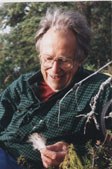B.S. Forestry, 1937 - posthumous award

David L. Spencer
David L. Spencer, class of '37, died in February 2000 at the age of 84. He was born near Philadelphia in 1915.
After completing his forestry degree, Spencer worked for a few years with the Civilian Conservation Corps, and then as a logger in northwestern Pennsylvania, felling trees and cutting them in to firewood. This was during the Great Depression and before the invention of chain saws. Next Spencer borrowed money and enrolled at the University of Michigan. After completing an M.S. degree in the new field of wildlife management, he began a job with the Missouri State Game Commission in 1942. In 1943, with America engaged in World War II, Spencer enlisted in the Naval Air Corps and became a naval flight instructor in multi-engine seaplanes at Corpus Christi, Texas.
Spencer was discharged from the Navy in 1945 and soon began working with Starker Leopold, the son of Aldo Leopold. They conducted bird studies in Mexico, traveling by foot and horseback; this was a comprehensive study under the auspices of the University of Wisconsin. Spencer then began doctoral studies at the University of Wisconsin and it was there that he came to know Aldo Leopold. After six months he knew that research was not his preferred vocation and he entered the U.S. Fish and Wildlife Service in 1946. Because of his aviation experience he was a natural to fly the aircraft that the agency relied on heavily. In addition he had extensive experience in forestry and wildlife management. He flew duck surveys in Mexico, Guatemala, Florida and Canada, as well as flying in remote areas of Alaska in the late 1940s and 1950s.
In 1948, the year he married his wife Eloise, he became refuge manager of the Kenai National Moose Range. Although there were 14 national wildlife refuges in Alaska at that time, Spencer was only the second manger appointed anywhere in the territory. In 1950 his duties were expanded to serve as supervisor of all the national wildlife refuges in Alaska. He fought for and guided the Alaskan National Wildlife Refuge System through the turbulent years of poachers and squatters, oil development, statehood, emerging wilderness and environmental ethics, conflicting demands for use of wildlife and their habitats, and the selection of lands to be added to the refuges for the Alaska National Interest Lands Conservation Act (ANILCA). He was instrumental in bringing back the Aleutian Goose from the brink of extinction. With the help of his colleagues, Spencer instigated the establishment of the Kenai Canoe Trail System. He retired from the U.S. Fish and Wildlife Service in 1976 and then worked an additional eight years for the University of Alaska.
Spencer's professional recognitions are numerous and include the highest honor of the Department of Interior, the Distinguished Service Award in 1973; the Alaska Conservationist of the Year award from the National Audubon Society in 1981; and the Professional Service Award from the University of Alaska in 1985. In 1997, a unit of the Kenai Wilderness was named in David Spencer's honor.
Dr. John Craighead provided a letter in support of Dave's nomination and wrote, "I know of no other who has done as much as Dave to preserve and manage wildlife and its habitat in Alaska. He was a humble and soft-spoken man but resolute in his husbandry of the land and its wildlife. Hi integrity was of the highest order and this was matched with a passion for the land and its diversity of like. It is my opinion that he, more than anyone else, set the pattern for natural resource management in Alaska."
Department of Ecosystem Science and Management
- Office 814-865-7541
- Fax 814-865-3725
Department of Ecosystem Science and Management
- Office 814-865-7541
- Fax 814-865-3725

